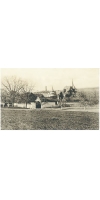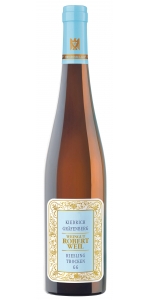Wine from Robert Weil

SIR SUTTON'S LEGACY A WEALTHY PATRON OF THE ARTS BY THE NAME OF SIR JOHN SUTTON FIRST ARRIVED IN KIEDRICH IN 1857. HE FELL IN LOVE WITH THE TOWN FOR ITS LANDSCAPE AND CHARACTER, INCLUDING THE GOTHIC ST. VALENTINUS CHURCH, ITS VARIOUS NOBLE ESTATES AND THE RUINS OF SCHARFENSTEIN CASTLE. SUTTON DIED IN 1873, AND DR. ROBERT WEIL ACQUIRED HIS MANOR AND SETTLED IN KIEDRICH TWO YEARS LATER
WHILE PRIMARILY ENGAGED AS A JOURNALIST, DR. ROBERT WEIL ALSO BEGAN EXPANDING HIS WINE HOLDINGS THROUGH THE ACQUISITION OF SOME OF KIEDRICH'S FINEST HILLSIDE SITES. HIS UNCOMPROMISING DEDICATION TO QUALITY IN THE VINEYARD PROVED PROPHETIC AND LED TO THE RAPID DEVELOPMENT OF THE ESTATE AND AN INTERNATIONAL AUDIENCE FOR HIS WINES.WELCOME AT ANY TABLE
AS THE WHITE COUNTERPART TO THE GRAND RED WINES OF BORDEAUX, THE RIESLING AUSLESEN FROM WEINGUT DR. WEIL HISTORICALLY GRACED THE TABLES OF MANY OF EUROPE'S NOBLE AND IMPERIAL HOUSES
WEIL'S RIESLINGS WERE FAVORITES NOT JUST OF THE ARISTOCRACY, BUT ALSO OF THE PROSPERING MIDDLE CLASS. AUSLESE WINES FROM THE KIEDRICHER BERG WERE REGULARLY FEATURED IN BERLIN'S HOTEL ADLON AND THE WINE LISTS OF OTHER GRAND METROPOLITAN HOTELS. A 1920 KIEDRICHER GRÄFENBERG TROCKENBEERENAUSLESE BESTES FASS NR. 20 FROM DR. WEIL'S ESTATE ENRICHED THE WINE LIST OF THE "LZ 127 GRAFZEPPELIN" AIRSHIP ON ITS MAIDEN VOYAGE IN 1928 TO NEW YORK.HIGH SOCIETY
THE SON OF THE ESTATE'S FOUNDER, ATTORNEY DR. WILHELM WEIL, ASSUMED THE HELM IN 1920. BEYOND HIS INVOLVEMENT WITH POLITICAL ISSUES AFFECTING WINEGROWERS — THE ESTATE HAS BEEN A MEMBER OF THE VDP AND ITS PREDECESSOR ORGANIZATIONS SINCE 1907 — HE ALSO SUCCESSFULLY NAVIGATED THE ESTATE THROUGH DARK AND TURBULENT TIMES. STARTING IN THE 1950S, HIS WINERY REATTAINED ITS STATUS AS A POPULAR DESTINATION FOR WINE CONNOISSEURS.
DR. WILHELM WEIL'S SON ROBERT, ALSO AN ATTORNEY, WAS NEXT TO ASSUME THE REINS TO THE ESTATE. STARTING WITH THE FAMOUS 1959 VINTAGE, HE RETURNED RIESLINGS FROM THE KIEDRICH VINEYARDS TO THEIR PREVIOUS PROMINENCE BOTH IN GERMANY AND AROUND THE WORLD.
ONCE UPON A TIME, THE VISION AND ENTREPRENEURIAL COURAGE OF DR. ROBERT WEIL PROVED ESSENTIAL TO THE SURVIVAL OF THE ESTATE. AFTER ALL, HIS PRIVATELY OWNED WINERY HAD TO STAY AFLOAT IN A SEA OF NOTABLE RHEINGAU ESTATES WITH DEEP-ROOTED TIES TO THE CHURCH OR ARISTOCRACY. HIS GREAT-GRANDSON WILHELM WEIL HAS CARRIED THAT BOLD APPROACH INTO MODERN TIMES.
Wilhelm Weil learned the intricacies of winemaking from the ground up. That education has shaped the many decisions that now define the fortunes of the estate. His efforts began in 1987 with far-sighted investments in the cellar and vineyards and the introduction of the "Tiffany Blue" label. As the founder's great-grandson, there is real pride in the global attention being accorded once again to Weil Rieslings.
EACH WEIL RIESLING EXPRESSES A SIMULTANEOUS ELEGANCE AND COMPLEXITY ORIGINATING IN THE DISTINCTIVE, STONY CHARACTER OF THE KIEDRICH HILLSIDES. THE WEIL STYLE, HOWEVER, HAS DONE MORE THAN JUST EARN INTERNATIONAL RECOGNITION FOR THE ESTATE. IT HAS ACHIEVED A SYMBOLIC STATUS ON THE WORLD STAGE AND HELPED RAISE THE INTERNATIONAL PROFILE OF GERMANY’S UNIQUE RIESLING CULTURE.
Weingut Robert Weil Kiedricher Grafenberg Riesling Grosses Gewachs is made from 100 percent Riesling.
The Robert Weil Kiedrich Grafenberg GG is always at the head of its class. Deep, brooding, powerful aromas of sea salt, ripe lime, lemon curd and jasmine. Bass notes of moist earth. Explosive flavors of pineapple, honey, peach, apple and spearmint. So much fruit, but bone dry. Aristocratic finish.
A powerful, almost monolithic Riesling, that can stand up to buttered lobster, Eastern scallops, a roast garlic chicken, or just an array of ripe cheeses.
Review:
“This very youthful GG needs some aeration to open up, but with every swirl of the glass more wild herbs, red-fleshed vineyard peaches and exotic floral nuances emerge. Very concentrated, yet cool and focused, with a very precise interplay of tangerine fruit, wet-stone minerality and a hint of oak that echoes down the valleys.”
Founded in 1875, Weingut Robert Weil is considered to be one of the Rheingau’s younger wine estates. It is located in the heart of Kiedrich, a village first documented in the year 950. Kiedrich Turmberg and Kiedrich Gräfenberg, the estate’s top vineyards, are among the finest sites in the Rheingau.
-James Suckling 98 Points
- back
Selected Options
Wineries
Categories
Pricing
Countries
Regions
Grape Types
Wineries
Organic/Free Shipping
Chateau de Beaucastel Chateauneuf-du-Pape Rouge is made from 30% each Grenache and Mourvèdre, with 10% each Counoise and Syrah, plus 20% other permitted varieties, including a healthy proportion of white grapes.
The story :
Château de Beaucastel has long been considered one of the great wines of France. It is unanimously renowned for its balance, elegance and ageing potential. Beaucastel has an extraordinary terroir at the Northern end of the appellation with heavy exposure to the Mistral. All 13 varieties of the appellation have been organically grown here since the sixties.
Location :
Châteauneuf du Pape, between Orange and Avignon, Château de Beaucastel red is a 70-hectare vineyard.
Terroir :
Château de Beaucastel is 110 hectares, with one single plot at the north of the appellation. The terroir is archetypal of the best terroirs in Châteauneuf: rolled pebbles on the surface, sand, clay and limestone deeper down. The vines are old and have been organically grown for 50 years, which has allowed the roots to grow exceptionally deep.
Beaucastel grows all thirteen grape varieties authorised by the appellation.
Ageing :
Each variety is harvested manually and separately. Vinification is completed in truncated oak barrels for the reductive grapes (Mourvèdre and Syrah) and in traditional tiled cement tanks for the oxidative grapes (such as Grenache). After the malolactic fermentations, the family blends the different varieties and then the wine ages in oak Foudres for a year before bottling.
Review:
deep, quite herbal expression, with liquorice and crushed blueberries to the cassis fruit. Full-bodied, powerfully fruited, dense and deep. Really mouthcoating, intense fruit. The tannins are ripe, fine and plentiful, all saturated in blackberry juice on a long finish. Certainly one of the more successful Châteauneufs this year. Will age well. A Mourvèdre-led expression of Beaucastel - it contains more than usual, at least 35% and probably more. Grenache and Cinsault fermented in cement, Syrah and Mourvèdre fermented in foudre. (MW) (9/2022)
-Decanter 96 Points
Michel Thomas Sancerre Blanc is 100% Sauvignon Blanc (40% Caillottes, 40% Grosses Terres, 20% Silex)
The wine displays an exotic nose with a touch of smoke and licorice. On the palate, peach and watermelon dominate with citrus zest and chalk notes.
Aged on the lees for a few months (no oak). It goes well with seafood, fish, goats cheese.





